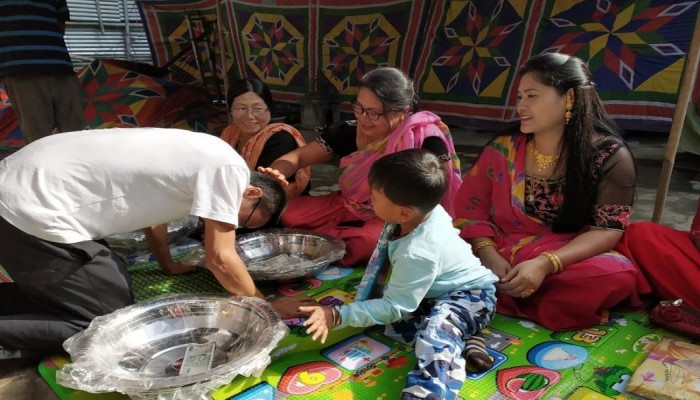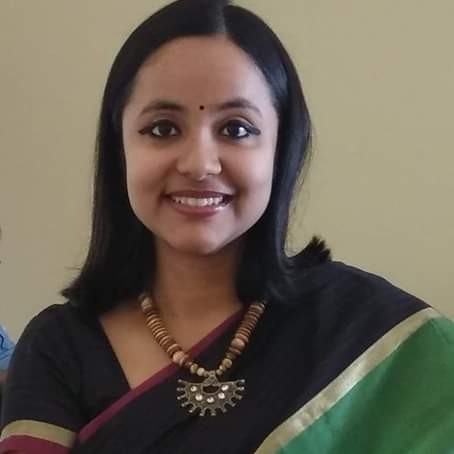Ningol Chakouba of Manipur: A Festival of Celebrating the Spirit of Sibling Love and Much More Part-1
- In History & Culture
- 11:21 AM, Nov 16, 2020
- Ankita Dutta
While listening again and again to the soulful rendition of Vande Mataram by Esther Hnamte, a 4-year old cute little kid from Mizoram, my mind again started to wander in its own sea of thoughts. In traditional wedding ceremonies across different states of India, there is a custom of engaging the newly-married couple in several games as a part of the post-wedding rituals. In Assam, one such game is called Aanguthi-Khela in which the wedding rings of both the bride and the groom are hidden in a huge vessel filled with raw, uncooked rice. The newly-weds are supposed to search for one another’s rings in the rice vessel, while the elderly ladies add to the atmosphere their own aura of merriment by singing numerous songs called Biya-Naam. These songs are sung in enthusiastic praise of the virtues of marriage, childbirth, and growing old together. The saying goes so that whoever is able to find the ring in the first place, will be definitely going to have an upper-hand in the marriage.
A friend from Rewari, Haryana recounted a similar tale to me during one of our conversations at a friend’s wedding ceremony in Delhi. They have a somewhat similar ritual, the only difference being that in place of rice, the rings are dipped in a vessel of milk or ghee. The womenfolk gather around to shower praises on the couple through different folk songs popular in the region. The striking similarity of this ritual and several others as practised in a Northern Indian state to that of a border state in Northeast India bears ample testimony of the idea of oneness that the Indian cultural civilisation has nourished since time immemorial. The wedding songs sung by women in both the regions are reflective of a common pan-Indian way of life that binds all the different and disparate cultures and societies of Bharatvarsha into one single entity. These songs are passed on orally by women from one generation to another and hence are a repository of the rich cultural handover.
The Hindu festive season begins after the end of the 16-day period of Shradh-Paksha/Pitr-Paksha, immediately after Ganeshotsav on the full moon day of Purnima Shradh and concludes on the new moon day called Sarvapitru Amavasya. It not only corresponds to the changing cycle of seasons but also connects different geographical regions of India from the North to the South and from the West to the Northeast on a common cultural plane. Although much of Northeast India has served as a perfect laboratory for the Church, yet there are sections of people who have still been able to fiercely hold on to their own culture and traditions, and most importantly, their faith and belief systems. Besides Assam, the state of Manipur and particularly the lush-green Imphal Valley, stands out as an apt example of the same. United by a common thread of civilisational oneness, the diverse festivals celebrated by the people of Northeast India showcase the rich cultural and societal values of the people here at its optimum best.
Manipur – A Brief History of the Land & its People
Bordering the Southeast Asian nation of Myanmar in the northeast, Nagaland in the north, Mizoram in the southwest, and Cachar district of Assam in the west, Manipur represents a rich mosaic of traditions and unique cultural patterns. Manipuri handlooms and handicrafts such as bedsheets and bedcovers, embroidered textiles, colourful shawls, curtains and table mats made of water-reed, cane and bamboo crafts, wood carving, souvenirs, etc. are famous the world over for their unique craftsmanship and remarkable ingenuity, vibrant colours and utility.
The ancient kingdom of Manipur, a neighbour and ally of the Shan kingdom of Upper Burma called Pong, was formed as a result of the amalgamation of several independent principalities under the leadership of Nongda Lairen Pakhangba (33-154 A.D.), who belonged to the Ningthouja salai (clan). Pandit N. Khelchandra Singha opines that the word ‘Meitei’ which eventually came to be used to refer to the people of the Manipur Valley, was originally applied only for the Ningthoujas. It was after the formation of the confederacy of the salais and its subjugation by the Ningthoujas that the word ‘Meitei’ or ‘Meetei’ became the common nomenclature for all those people inhabiting the Manipur Valley.
Commonly known to the outside world as Meitei Leipak and Poireinamthak Saron Pung, Manipur inevitably formed an important link, culturally and otherwise, between India on the one hand and Southeast Asia on the other. It was referred to as Kathe by the Burmese, Mekhali by the Ahoms, Kangleipak, Sanaleibak, or Meitrabak in a few ancient texts such as Panthoibi Khongul, Pombi Luwaoba, etc. written by Meitei scholars. With the gradual popularity of Vaishnavism in the valley during the reign of King Pamheiba, Kangleipak soon came to be known as Manipur, having Sanskrit roots (Mani meaning ‘Jewel’ and Pur meaning ‘Land’). There is a popular Vedic belief that the valley of Manipur was once submerged deep under water. It was only when Shiva had pierced the hill Chingnunghuk with his Trishula that led to the creation of a hole, which helped to drain the water out and the valley finally became habitable. As a mark of celebration of the happy event, Shiva together with a host of other Devis and Devtas performed a dance which is believed to have been the Lai Haraoba dance form still popular in Manipur.
Overwhelmed at the beauty of this land and Shiva’s dance, Vishnu sprinkled it with precious, sparkling gems; hence, the name Manipur. The worship of Vishnu in the form of a serpent or python identified as Pakhangba in the Meitei religious pantheon has thus been in vogue among the people of Manipur since antiquity. In fact, the name of the district Bishenpur or Bishnupur, hailed as the cultural and religious capital of Manipur, has been derived from Bisnu/Vishnu. The Sakta cult of Ma Durga is also widely prevalent in Manipur among different sections of the Meiteis. The travelogues of the Chinese Buddhist pilgrim Huien Tsang in the 7th century A.D. are dotted with several references of Manipur in the context of the kingdom of Kamarupa. In the 15th century, Gaudiya Vaishnavism of Sri Chaitanya became immensely popular in Manipur as a result of the efforts of King Bhagyachandra who, along with his daughter Bimbavati Devi, visited Nabadweep and established a temple here dedicated to Govinda. This strand of Bengal’s Gaudiya Vaishnavism continues to influence the cultural life of the people of Manipur even today, the primary examples being the traditions of Nat Sankirtana, Manohar Sai, and Krishna Ras Leela.
Geographically speaking, Manipur is nestled in the grace and grandeur of nature with rugged hills on all the sides and a fertile saucer-shaped valley (Kongba) in the centre that constitutes a mere 8% of the land area of the state. It was after the Treaty of Yandaboo (1826) that the erstwhile kingdom of Manipur, then ruled by Raja Jai Singha, was annexed into the British Empire. It formally came under the British rule as a princely state in the year 1891. Imphal was occupied by the Japanese forces during World War II. After India attained Independence from the British Raj in 1947, Manipur became a Union Territory and it subsequently achieved full-fledged statehood on January 21, 1972. It is one of the least populated states of India and a paradise largely unexplored.
The three most important ethnic groups inhabiting present-day Manipur include the valley-based Hindu Meiteis which are the most dominant, numerically; the hill-based, predominantly Christian Naga communities such as Kabui, Tangkhul, Khoirao, Maring, etc.; and, the Kukis which are relatively smaller in number, e.g. Thadou, Hmar, Vaiphei, Gangte, Simte, Zou, etc. Almost all groups of the Nagas and Kukis in Manipur have adopted Christianity as their religion. The increasing popularity of Christianity in Manipur can be gauged from the fact that it is today the second fastest-growing religion in the state, accounting for about 35% of the total population. Marwaris, Bengalis, Biharis, and Punjabis are some of the other communities residing in different districts of Manipur.
Meiteis of Manipur & Ningol Chakouba
The Meiteis (derived from Mei meaning man, and Tei meaning the worshippers of Sanamahi – the Chief Creator of the Universe) are a significant ethnic group in the Northeast that has strongly resisted the aggressive evangelist missions of the Church. The valley being adequately safeguarded by the surrounding mountain ranges is still not easily accessible; hence, the Meiteis have been able to preserve their own distinct cultural traditions, art, music, and dance forms from appropriation by any foreign force. The Hindu Meities of Manipur worship the tulsi plant and revere Lainingthou Sanamahi (Sidaba Mapu or King of the Gods) as their chief protector and saviour even today. Being ancestor worshippers, they share much in common with the Tai-Ahom community of Upper Assam. The Buranjis (historical texts) of the Ahoms are replete with several references of matrimonial alliances between the Ahoms and the Meiteis. The Meiteis are linguistically close to the Burmese, Kachins, Singphos, and Bodos. Their language Meiteilon or Maitai (also known as Manipuri), is the lingua franca of the state, and was recognised as one of the national languages of India under the 8th Schedule of the Constitution in the year 1992.
Just like most other states of Northeast India, Manipur is also a hill state. Its picturesque valley has served as the cradle of a rich civilisational heritage of not only the Meiteis but that of the hill-dwellers too. One of the most important and biggest festivals of the Meiteis of Manipur is Ningol Chakouba. In the Meiteilon language, Ningol means daughter, whether married or unmarried; while Chakouba implies an invitation for lunch in her maternal home. It is celebrated every year two days after Kali Puja, and coincides with Bhaiyya Dooj in North India, Bhau Beej in Western India, Bhai Phonta in Bengal and Odisha, Yamadwitiya in a few parts of Southern India, and Bhratridwitiya in Andhra Pradesh and Telangana. It also shares a close resonance with the festival of Raksha Bandhan. This year, Ningol Chakouba is going to be celebrated in Manipur on November 17.
Nowadays, this festival is also observed with equal fanfare by the Meitei Pangans/Pangals or Manipuri Muslims, whose ancestral roots in Manipur date back to the time of King Khagemba. They are a numerically small yet quite significant section, settled largely in the Imphal Valley, besides a scattered population residing in Assam’s Barak Valley, Tripura and Nagaland. They have adopted Meitei language as their mother tongue and their customs and traditions such as food habits, sense of dressing, the festivals they celebrate, etc. are not very different from the Hindu Meiteis. The Kabui Nagas also celebrate Ningol Chakouba in much the same manner as that of the Meiteis.
Origins & Significance of Ningol Chakouba
Ningol Chakouba is a festival of the celebration of the maternal line of familial affection – a perfect epitome of the unique cultural heritage and traditional ancestry of Manipur. According to some ancient Manipuri literary sources, it started during the period of Chakmei-Singmei, i.e. before the annual crop harvest, when Goddess Jamuna invited her brother Yamaraj (Hindu deity of death) for a feast. Also known by the name of Hiyanggei Nini Panba, Ningol Chakouba is generally observed after Deepawali and Govardhan Puja in late October or early November on the second lunar day of the Manipuri month of Hiyanggei. It is somewhat similar to the Bhagini Hastha Bhojanam celebrations of South India. The Meiteis celebrate their own version of Deepawali by decorating a pot full of rice called chengfu which is worshipped as Goddess Lakshmi.
The origins of Ningol Chakouba have been traced back to the 4th century when Poireiton Khunthokpa, one of the Manipuri kings who had many sisters, was invited for a meal by all of them together on the same day every year as a mark of Piba Chakouba (Piba meaning son). With time, it became increasingly difficult for him to attend all their invitations on the fixed date. So, he decided to invite all his sisters including Queen Laisana, on a day and date of his own choosing for a multi-course delicious lunch at his royal household. The king had also given each of them a bunch of home-grown bananas, vegetables, Chahao (sweet-smelling Manipuri white rice), and a hand-spun sarong (shawl) as gifts. Hence, it was from now onwards that Piba Chakouba came to be known as Ningol Chakouba, celebrated in honour of the eternal love between brothers and sisters.
Ningol Chakouba became especially popular in 19th century Manipur during the reign of Maharaja Chandrakriti. This age-old, distinctive practice has now become an inextricable part of Manipuri society and culture in which the worship of Ima Panthoibi (a local Goddess) occupies a position of special significance. It represents the pride of Manipuri Ningols (daughters and sisters) that celebrates their womanhood, the special bond of unconditional love and care they share with their natal family and more so with their Pibas (brothers). Ningol Chakouba is a nostalgic time for recalling some of their intimate childhood memories in the space where they were born and grew up to be a young lady. In the event of any inauspicious occurrence in the family such as death, the festival is not celebrated that year.
Ningol Chakouba is a much eagerly awaited and popular social festival especially for the married women, both young and old alike, belonging to the Meitei community of Manipur. Unmarried women too, are also equally welcomed. The married ones bring along with them their children to their mapaam (mother’s homes) every year as a mark of revival and strengthening of family ties. The very idea of getting dressed up in new clothes and meeting their bobok (grandmother), pupu (grandfather) and mamma (uncles), besides a host of other relatives is a reason enough for the kids to be happy about Ningol Chakouba. It is a gala event for families having many married Ningols and who are now settled at different places. It also provides an opportunity for people across different generations within the same family to meet and get to know each other, especially at a time when the virtual has come to replace the ‘human’ in human relationships.
Merry-making and thanksgiving are an important part of the celebrations that are all about nurturing of blood relationships, an annual family reunion, and a leisurely get-together. Ningol Chakouba has a very strong emotional sentiment attached with it. The beloved daughters of the family and their children (if they are married) are the main focus of attention on this special day, when they are showered with all the love and attention from their parents, neighbours and brothers. Generally, the traditional norm has been that the husbands of the daughters/sisters are not a part of the celebrations. A popular saying in Manipur goes so that women who whole-heartedly accept the hospitality of their brothers on Ningol Chakouba need not fear death. The Pibas of the family send invitations to the Ningols a week in advance for a grand lunch party to be hosted in their welcome. The invites aren’t ordinary cards, but are exquisitely crafted from betel leaves or paan which are rolled over a few freshly-cut betel nuts known as tambula in Sanskrit.
Both paan and tambula symbolise freshness and prosperity and are considered sacred in several Vedic religious rites and rituals. Dakshina to gurus and elders is generally offered by placing a betel nut along with a coin in the betel leaf in many parts of Southern, Eastern and North-eastern India. Because of their intrinsic health and healing properties, betel leaves are also used to adorn the kalash for it is believed to purify the water inside. Betel leaves having holes, or the ones which are dry or torn in the middle are not utilised for any auspicious occasion.
A Social & Community Festival
On the day of Ningol Chakouba, the women carry baskets of fresh fruits (coconut being a must), seasonal vegetables, cooking oil, spices, betel nuts and paan, special homemade sweets, assorted chocolates and snacks such as Kabok Khoidum, Rasogulla, Samosa, Kachori, Sev Bhujia, etc. for her family members as a token of love and affection. This tradition of bringing edibles by the Ningols is known as athenpot or khudolpot among the Meiteis. It is believed to be in reverence for her dead ancestors. Traders deal in an assortment of imported fruits and traditional sweets and namkeens in order to cater to the surging demand. The Ningols’ parents and brothers pamper them with clothes, jewellery, utensils, cash, etc. which are bestowed upon them as gifts for the occasion. The brothers apply a chandan tilak in their sisters’ foreheads. The sisters, in return, bless (bor) their brothers in bowing heads with good fortune and a prayer for their long, healthy and wealthy life. They also bring special gifts for their brothers to mark the occasion.
All these customs are said to protect the sacred Piba-Ningol relationship from any evil eye and bring all-round happiness, success and prosperity in both their lives. The kids are also given gifts of clothing and toys along with the Ningols. In cases where both the parents have died and the brothers are no longer staying in their family home, the women make it a point to visit their brothers’ homes on the occasion even if the latter are settled in far-away places. Women who are the only daughters in their families and do not have a brother of their own, are called upon by their parents to grace the event. Women clad themselves in the finest of designer jewellery and intricately designed traditional Manipuri outfits such as wangkhei phee (a GI-registered popular cotton attire worn by Manipuri women on special occasions), phanek (a long skirt tightly draped around the waist), rani phee (a half-saree worn in the form of a dupatta together with a phanek), and innaphi (a gorgeous shoulder drape with attractive borders very similar to a shawl that is worn over the blouse).
It is extremely charming and beautiful to see these women on the roads going to their maternal homes with their children to meet their parents and brothers on the day of Ningol Chakouba. After sunset, everyone in the family bid a goodbye to the Ningol who happens to be the queen of the occasion.
A delicious feast popularly known as utsav, is prepared on the day of Ningol Chakouba by the bamon (cook) who is especially arranged by the Ningol’s family. The preparation for the feast begins early in the morning. All the siblings and other friends, neighbours and family members, including the parents of the Ningols sit on the ground and have a relishing lunch together in an unusually long session. Accompanied by sweet chitter-chatters and giggling, it is one of the most significant aspects of the festival which is reminiscent of a conventional Manipuri Mapaam Chakouba (wedding reception). However, the participation of neighbours in the luncheon is optional, depending upon invitation by the host. In case the neighbours join in the feast, they too, bring along with them gifts of clothes, vegetables, and locally-grown rice, etc. for the Ningols to take to their husband’s home. It is because of the fact that in a traditional Indian village setting, one’s daughter is considered to be everyone’s daughter even today.
Many families ensure that the feast is prepared in the same old kitchen from where the Ningol had enjoyed having her food together with her parents and siblings before she got married. Every effort is being made to ensure that the taste buds of the Ningols are carefully kept in mind while preparing the meal. It is indeed an indescribable feeling of experiencing and reliving those same old memories again afresh with everyone gathered around the same place and at the same time.
References:
- Dipanjan Roy Chaudhury. (2008). Northeast: Diverse Complexity. India: Har Anand Publications.
- S. Gajrani. (2004). History, Religion and Culture of India, Volume 3. India: Gyan Publishing House.
- Rena Laisram. (2009). Early Meitei History: Religion, Society & The Manipur Puyas. Delhi: Akansha Publishing.
- Naorem Sanajaoba. (1988). Manipur, Past and Present: The Heritage and Ordeals of a Civilisation, Volume 4. New Delhi: Mittal Publications.
- https://www.google.com/amp/s/nenow.in/north-east-news/manipur/ningol-chakouba-a-manipuri-fiesta-of-inviting-wedded-daughters-to-feast.html/amp
- http://e-pao.net/epSubPageExtractor.asp?src=leisure.EI.A_Ningols_Chakouba_Wish
- http://www.epao.net/ep/SubPageExtractor.asp?src=manipur.Festival_of_Manipur.Story_behind_Ningol_Chakkouba
Image Credit: Times of India
Disclaimer: The opinions expressed within this article are the personal opinions of the author. MyIndMakers is not responsible for the accuracy, completeness, suitability, or validity of any information on this article. All information is provided on an as-is basis. The information, facts or opinions appearing in the article do not reflect the views of MyindMakers and it does not assume any responsibility or liability for the same.







Comments